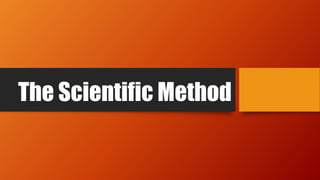The document describes the scientific method as a systematic process used to explore observations and answer questions through experimentation and testing hypotheses. It outlines the 5 basic steps of the scientific method as: 1) asking an observation-based question, 2) gathering preliminary data, 3) formulating a hypothesis, 4) conducting an experiment to test the hypothesis, and 5) drawing conclusions from the experimental results to either support or disprove the original hypothesis. The document provides examples of how scientists like Lavoisier used these steps, such as formulating the hypothesis of phlogiston to later disprove it and develop the law of conservation of mass through controlled experimentation.



















